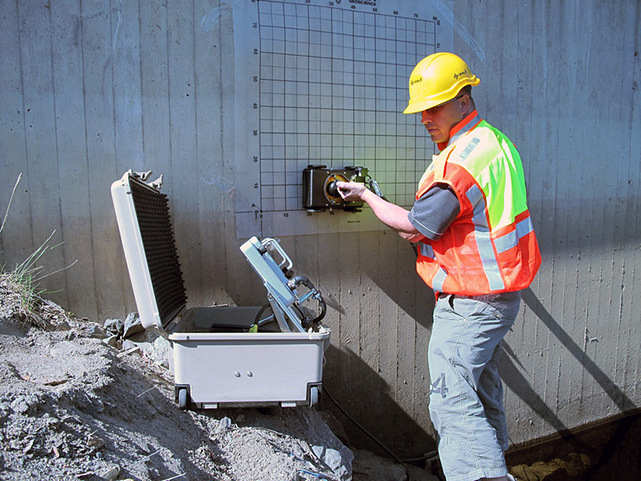Exploring the Midst: A Comprehensive Overview to Concrete Scanning and Its Diverse Applications
In the realm of building and construction and framework development, the precise procedure of concrete scanning holds an essential duty in making sure the architectural integrity and safety of projects. As innovation proceeds to evolve, the applications of concrete scanning have increased far beyond mere surface-level assessments. From identifying rebar and post-tension cable televisions to drawing up channels and gaps hidden within concrete structures, the capacities of modern scanning methods are both remarkable and necessary. The real depth of concrete scanning's potential reaches even further, branching into unanticipated industries and stimulating ingenious services. The interconnected web of possibilities that concrete scanning provides is not just remarkable but also crucial for the innovation of different sectors.
Significance of Concrete Scanning
Comprehending the value of concrete scanning is crucial in ensuring the safety and integrity of frameworks throughout building and construction and remodelling tasks. Concrete scanning utilizes innovative modern technologies such as ground-penetrating radar (GPR) and electro-magnetic induction to find ingrained items, gaps, or other anomalies within concrete structures.
Furthermore, concrete scanning plays a critical function in guaranteeing conformity with building ordinance and laws that mandate the protection of existing structural parts throughout construction tasks. By precisely mapping out the inner structure of concrete, scanning technologies allow building specialists to make informed decisions that support the architectural stability and sturdiness of buildings and infrastructure jobs. Essentially, the relevance of concrete scanning hinges on its capability to safeguard both the structural integrity and the personnel included in construction endeavors.
Technologies Utilized in Concrete Scanning
Concrete scanning counts on sophisticated innovations such as ground-penetrating radar (GPR) and electro-magnetic induction to accurately identify embedded items and abnormalities within concrete structures. Ground-penetrating radar runs by giving off high-frequency electromagnetic waves right into the concrete. When these waves run into different products or voids within the concrete, they jump back to the surface, enabling the GPR system to produce a comprehensive subsurface photo. This innovation is especially efficient in situating rebar, post-tension cables, channels, and various other things installed in concrete.
Electro-magnetic induction, on the other hand, works by producing magnetic fields around a concrete structure through a transmitter coil. When steel things exist within the concrete, they interrupt these magnetic fields, creating eddy currents to move with the metal. By measuring the changes in the electromagnetic fields with a receiver coil, the system can identify the place of metallic objects in the concrete.
These sophisticated technologies play a crucial duty in non-destructive screening, making sure the safety and honesty of concrete structures in various sectors.
Applications in Construction Market
Within the building and construction industry, concrete scanning technology locates diverse applications that boost project effectiveness and safety and security. One key application is the discovery of rebar, post-tension cords, and various other ingrained objects before exploration or reducing into concrete structures. By accurately mapping out these elements, building and construction groups can prevent expensive damages, ensure architectural stability, and avoid prospective safety hazards. Furthermore, concrete scanning is utilized for finding voids, such as air pockets or areas of wear and tear within concrete, which can jeopardize the total toughness of a framework. By determining these gaps early, construction specialists can take necessary procedures to resolve them and maintain the durability of the structure. Moreover, concrete scanning plays a crucial function in quality assurance by verifying the density of concrete covers over reinforcement, guaranteeing compliance with style requirements and criteria. On the whole, the applications of concrete scanning in the building and construction industry contribute considerably to enhancing task operations, reducing risks, and providing high-grade results.

Security Benefits of Concrete Scanning
In the realm of this contact form construction security, the implementation of concrete scanning innovation presents a vital advantage in preemptively determining possible hazards and fortifying architectural integrity. By using advanced scanning techniques such as ground-penetrating radar (GPR) and electro-magnetic induction, construction teams can accurately find rebar, post-tension wires, avenues, and various other surprise objects within concrete structures. This aggressive strategy substantially decreases the threat of unintended strikes during drilling, cutting, or coring tasks, therefore preventing costly damages, injuries, and job hold-ups.
Moreover, concrete scanning boosts worker security by supplying real-time information concerning the architectural condition of concrete aspects. This information makes it possible for construction specialists to analyze the integrity of existing website link frameworks, determine wear and tear or defects, and make notified choices relating to repair and upkeep treatments. By attending to potential safety worries quickly, concrete scanning adds to producing a safe workplace and reducing the probability of architectural failures or crashes on construction websites. Inevitably, the safety benefits of concrete scanning not only protect possessions and lives but additionally maintain market standards for top quality and integrity.
Future Fads in Concrete Scanning
Emerging developments in scanning innovation are positioned to change the area of concrete evaluation and analysis. By taking advantage of the power of AI, these systems can assess vast amounts of data gathered throughout scanning procedures to give even more comprehensive and precise insights right into the condition of concrete frameworks.
An additional substantial trend is the growth of more mobile and easy to use scanning tools. Miniaturization of scanning devices enables easier accessibility to confined rooms and remote places, making assessments extra effective and comprehensive. In addition, advancements in wireless communication innovations make it possible for real-time information transfer and evaluation, assisting in quicker decision-making processes.
Additionally, there is an expanding focus on sustainability in concrete scanning technologies - RainierGPR Concrete Scanning. Makers are progressively including environmentally friendly products and energy-efficient functions right into their tools to decrease ecological effect. These future trends are readied to boost the effectiveness, accuracy, and sustainability of concrete scanning practices, forming the industry's future landscape
Conclusion
In verdict, concrete scanning plays an important role in the building sector by making sure the safety and efficiency of various jobs. As modern technology advancements, the future of concrete scanning holds encouraging developments for enhancing building procedures.
